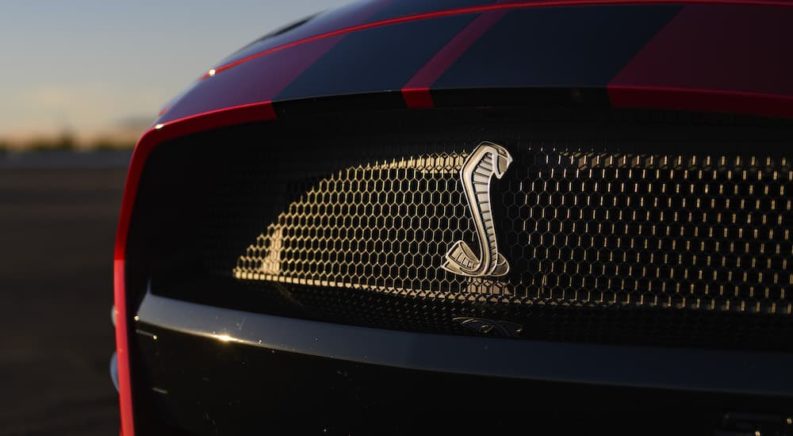“Anything worth doing is worth doing in excess.” Those are the words of American auto racer, designer, and entrepreneur Carroll Shelby, and one look at the 2022 Mustang Shelby GT500KR tells you this man knew what he was talking about. As a souped-up version of an already overpowered high-performance vehicle, the new KR, or “King of the Road” version of the legendary Shelby Mustang, is nothing if not excessive. Ford has long used the limited edition Shelby badge to show us just how much power it’s capable of packing under the hood, and the 2022 model is no different. Just one look at this vehicle at your local Ford dealer, and you’ll see the pride this company has for this limited-edition model.
Limited to 180 units domestically, it might be tough to actually get behind the wheel of a 2022 GT500KR anytime soon. Still, its reintroduction does give us a good excuse to dive into one of the most fascinating partnerships in American automotive history: the collaboration between Shelby and Detroit’s storied Big Blue Oval. The story is nothing new for well-read gearheads—it was even immortalized in 2019’s “Ford vs. Ferrari” starring Christian Bale and Matt Damon. However, it provides an in-depth look at how a retired racer and a major automaker, inspired by both the pursuit of perfection and desire to stick it to an enigmatic Italian auto magnate, produced one of the most iconic cars of a generation.
Pony up
When Ford created the Mustang in 1964 it didn’t just create a new vehicle; it created an entirely new class—the pony car. At its core, the idea was to develop a more compact version of the popular muscle cars that had enthralled drivers in the late 50s. While these souped-up performance vehicles were still as popular as ever, Ford saw potential in introducing a smaller, more affordable version that would provide the same hair-raising excitement and bold styling without the correspondingly high price tag. The result was the Ford Mustang, which proved so popular that its equine-inspired name was directly lifted as the moniker for the entire category.
The Mustang introduced a formula that would become popular across the American auto industry—high-performance vehicles with long hoods, short decks, youthful panache, and endless customization potential sold at a price that would make them available to a wide swath of drivers. The Mustang’s success was difficult to ignore. Before long, pony cars had become the industry’s hottest new trend, with the Chevy Camaro, Plymouth Barracuda, and Pontiac Firebird launched in direct response to Ford’s game-changing coupe.
Landing upon an idea so good that it inspires an entirely new class of vehicles should be enough to cement the Mustang’s legendary status, but in the eyes of many gearheads, the Mustang didn’t truly become the Mustang until Carroll Shelby came along. A legend in his own right, Texas-born Carroll Shelby turned a youthful obsession with speed into a vocation, studying aeronautical engineering in college before enlisting in the U.S. Army Air Corps prior to WWII. During his service, Shelby was a flight instructor and test pilot, flying a number of infamous aircrafts like the Douglas A-26 Invader and Boeing B-29 Superfortress.
Shelby was discharged following the war, but couldn’t shake the need for speed, becoming involved in the local Texas auto racing circuit before moving on to race internationally in South America and Europe. It was there Shelby made a name for himself, climbing the ranks and signing on with the Aston Martin racing team to take the checkered flag at one of the racing world’s most prestigious events, the 24 Hours of Le Mans. The endurance racing event is the sport’s oldest and unique format. Instead of awarding the trophy to the race’s fastest participant, success is based on how much distance a vehicle can cover over a 24-hour period. While pure speed is an important factor in any race, the unorthodox 24-hour competition emphasizes construction and reliability as a vehicle must withstand running at near-top speed for the entirety of the race. While Shelby would be forced to retire soon after his Le Mans podium appearance, his success in the French race would set the scene for his later career as an automotive designer; a fact that wasn’t lost on the man himself.
“Winning the Twenty-four Hours was probably the greatest thrill I ever got out of racing,” says Shelby in his 1965 autobiography “The Carroll Shelby Story.” “I can think of plenty of other races that carry their quota of thrills for the winner, but when you win this one, it kind of gives you license to go out and tell people you’re good, and that often helps get some other deals together.”
That deal would come knocking soon enough. After retiring from racing, Shleby had set up his own performance equipment and customization company, Shelby-American, wherein 1962 he produced the first vehicle to carry his name—the AC Cobra. The coupe hit the international racing circuit, received a few modifications, and eventually transformed into the Shelby Daytona Coupe, which would earn three GT class wins in 1964.
Ford (and Shelby) vs. Ferrari
These wins would draw the attention of Ford, which was looking for some help in getting its own GT40 Sports Prototype racing program off the ground. Ford’s desire to make a name for itself on the international circuit was a mix of professional interest and personal pride. This can be traced back to 1963 when Ford’s vice president Lee Iacocca convinced owner Henry Ford II to bid for Italian automaker Ferrari. The brand had fallen on hard times recently, but was a perennial favorite in the European racing scene with a solid track record at the 24 Hours of Le Mans, and Iacocca believed that purchasing the floundering Ferrari could up Ford’s own profile among racing fans. Enigmatic Ferrari owner Enzo Ferrari managed to parlay Ford’s offer into a much more equitable deal with Fiat, allowing Ferrari to retain control of the brands racing arm, Scuderia Ferrari. An incensed Henry Ford II took the snub personally and tasked Iacocca with designing a vehicle that would end Ferrari’s dominance at Le Mans.
As an American racing legend in the making with a recent win at the 24 Hours of Le Mans under his belt, Shelby was the obvious choice to head the project. Bringing years of experience both behind the wheel and under the hood, Shelby was able to revamp the GT40 into an instant competitor. The 1965 24 Hours of Le Mans was the GT40’s coming-out party, which was only spoiled by the fact that none of the three Ford entries finished the race. Still, the GT40 showed some promising flashes of brilliance, achieving an impressive top speed that motivated Shelby and Iacocca to redouble their efforts for the ‘66 race and design a new GT Mark II based around Ford’s 7.0-liter engine. Suffice it to say these changes did the trick, and the GT40s won the 1966 Constructors’ title with a 1-2-3 finish at the 24 Hours of Le Mans. The winning streak would continue well into the latter part of the decade, with Ford winning Le Mans three years in a row from ‘67 to ‘69.
King of the Road
Eager to capitalize on its success on the racing circuit and Shelby’s own celebrity, Ford tapped the designer to collaborate on a new vehicle aimed not at the rarefied tarmac of international racecourses but the streets of Anytown, U.S.A. Ford had introduced the Mustang in 1964, but saw the potential in launching a new version redesigned by the man who earned the brand that coveted French podium. Shelby took on the challenge, though he famously derided the task ahead to Iacocca, saying, “So, Lee, you want me to make a racehorse out of a mule?”
Good-natured ribbing aside, Shelby did just that—adding an aluminum intake that dramatically boosted the coupe’s horsepower and installing Shelby headers, a functional hood scoop, 15” wheels, a modified suspension, and of course, the classic blue drag stripes. The result was the Shelby Mustang, a spritely-yet-powerful coupe that allowed every red-blooded American teenager their chance to feel like they’re fighting for pole position at Le Mans. Ford also produced a limited number of variants, including the race-ready GT350R with 360 horsepower, but it was the next generation of GTs that would come to truly define the Shelby Mustang experience.
The 1966 edition of the Shelby Mustang, dubbed the GT350, represented a better balance between the coupe’s racetrack past and street-legal future. Shelby introduced a few features to aid overall ride comfort and usability, including extra trunk space, more color options, and a long exhaust pipe to reduce cabin noise. According to the man himself, the designer would continue to refine the formula and came close to perfecting it in 1967 with the GT500, “the first car I’m really proud of,” according to the man himself.
Featuring a massive 7.0-liter V8 427 CID engine and a number of race-inspired features like a roll bar, spoiler lip, and rear-facing air scoops in the place of rear quarter windows, the GT500 would become one of the most iconic vehicles of the era. Its cultural cache was still relevant more than 30 years later when it would be featured as Nicolas Cage’s dream car “Eleanor” in the 2000 car heist film “Gone in Sixty Seconds.”
1968 saw the introduction of the precursor to the 2022 Mustang Shelby GT500KR. While Ford also produced a GT350 and standard GT500 for the ‘68 model year, the GT500KR was the real showstopper. Shelby’s influence was clear on this limited variant, producing an almost unheard of 400 horsepower and 440 pound-feet of torque. After all, this was the man who once said, “Horsepower sells cars, torque wins races.” The pony car featured a 428 Cobra Jet V8 engine made all the more powerful with the addition of a ram air scoop, allowing it to achieve feats of rubber-burning strength previously unseen in the category.
Ford would revive the Shelby Mustang a few times throughout the following 50 years, but the GT500KR had only seen one contemporary iteration in 2008 and 2009 when about 1,700 units were produced. Modern automotive technology allowed Ford to squeeze 540 horsepower out of the Shelby Mustang, allowing the car to live up to its reputation and race-inspired heritage. The 2022 edition represents an even more overpowered version of the famous brand, so let’s take a closer look and see just exactly what it offers.
SUB – 2022
The 2022 Mustang Shelby GT500KR is unmistakably of the same lineage as those which rolled off the production line back in 1968, but with a few modern tweaks that would certainly gain the Shelby seal of approval. Chief among these is the introduction of carbon fiber components throughout, from the hood to front splitter and rear diffuser, which, along with new lightweight, one-piece aluminum-forged wheels, jibes well with Shelby’s ethos of “we’re lighter, we’re faster, and if that don’t work, we’re nastier.”
The styling is just as aggressive and race-ready as one would expect from a Shelby Mustang. Keeping true to the pony car theme, customization options are many—from an optional wide-body kit to enhanced stripes, a polished supercharger, and the option to remove the rear seat. Still, it’s the upgrades under the hood that truly earn it the name. Such upgrades include a new 5.2-liter V8 that can pump out a mind-blowing 900 horsepower on 93-octane, a 3.8-liter supercharger with a high-volume intercooler and heat exchanger, recalibrated MagneRide suspension, and front and rear sway bars.
“In ‘68, Carol Shleby took the GT500 to a new level with a Cobra Jet 428 that was just coming out. The big power difference this time is the supercharger which is going to deliver over 900 horsepower at the flywheel. In addition to that, it’s going to be very repeatable,” says Gary Patterson, president of Shelby American.
The 2022 Mustang Shelby GT500KR will be a limited run, with just 225 models produced and 45 of those reserved exclusively for the international market. The remaining 180 vehicles will sell in North America, with the first model being auctioned off for charity by Barrett-Jackson. The GT500KRs will retail for $127,895, though drivers who already own a GT500 can send it to Ford for a full KR-upgrade for $54,995.
While the GT500KR is sold as an automatic, the coupe’s unique double-clutch construction gives drivers many of the race-inspired advantages of a manual transmission. “It rev matches and upshifts and downshifts and basically thinks for you, though you can use the pedals if you want to be aggressive. We’ve had (professional test driver) Billy Johnson in it and he can’t hardly beat the thing with the pedal shifter,” says Patterson.
Senior Designer and Shelby American VP Vince LaViolette says the GT500KR provides the perfect excuse for Shelby and Ford to flex their automotive muscle. “We kinda went over and above where we normally go with one of our cars because the 500 is over and above to start with,” he says. “We said, ‘Okay, let’s pull out the stops and make a car that we can really have fun with.’ ” True to his word, fun is not in short supply when it comes to the GT500KR. The team at Shelby American has pulled out all the stops, using every trick in the book to squeeze all it can out of the limited-edition Mustang. These tricks include European spring packages rarely seen on the domestic scene, a tweak to the car’s suspension algorithm and a reimagined rear diffuser does a better job of keeping everything cool. “It’s very comfortable on the street and when you get it on the track doing 130 MPH as you’re going into the corner: she’s ready to go” says LaViolette.
With two of the most storied names in American automotive history stamped onto the badge, there is no doubting the pedigree of a car like the 2022 Mustang GT500KR. The Mustang isn’t just a collector’s item—it’s a testament to the advanced technology and obsessive engineering that makes a vehicle like this possible to begin with, not to mention a piece of history and a first-of-its-kind vehicle that launched an entirely new class upon its debut. Shelby’s expertise is on full display with the 2022 Mustang GT500KR, and the coupe retains that iconoclastic sense of attitude that made it so popular even 50-plus years since it burst onto the scene. Shelby Mustang is already a phrase that can make any gearhead’s heart skip a beat, and the latest iteration carries on that proud, heart-stopping tradition. Call it bold, call it brash, just don’t call it a mule unless you want to end up choking on someone else’s burned rubber.




